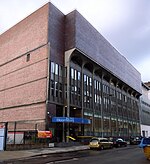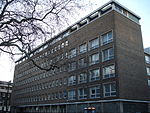Friends House
Grade II listed buildings in the London Borough of CamdenQuaker meeting houses in LondonQuakerism in EnglandQuakerism in LondonUnited Kingdom religious building and structure stubs

Friends House is a multi-use building at 173 Euston Road in Euston, central London, that houses the central offices of British Quakers. The building is also the principal venue for North West London Meeting and the Britain Yearly Meeting. In November 2014, a major refurbishment of the Large Meeting House was completed and the hall is commercially marketed as "The Light".Also at the site, for public use, there are restaurant, coffee bar, bookshop and a quiet area for personal meditation and worship.
Excerpt from the Wikipedia article Friends House (License: CC BY-SA 3.0, Authors, Images).Friends House
Euston Road, London St Pancras (London Borough of Camden)
Geographical coordinates (GPS) Address External links Nearby Places Show on map
Geographical coordinates (GPS)
| Latitude | Longitude |
|---|---|
| N 51.5263 ° | E -0.1326 ° |
Address
Friends House
Euston Road
NW1 2EF London, St Pancras (London Borough of Camden)
England, United Kingdom
Open on Google Maps











